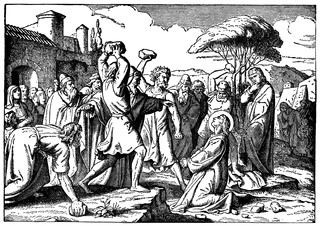My mind almost immediately transforms into an ongoing spider web of thoughts every time I plunge deep into early Christianity and Church history. My latest web of connecting dots between various movements, church influencers, and early Christian practices now includes martyrdom, asceticism, and what constitutes a devoted Christian life.
I will start with a Bishop Robert Barron interview I watched awhile back: He was asked about women not serving as priests in the Catholic Church, and his bottom-line response was that the end goal of every Catholic should be to become a *saint*.
As Bishop Barron explained that because priests, for example, are here to serve the laity and help us on a path toward sainthood, there is no greater status in this world but to be the full definition of goodness, a mirror of Christ’s sacrifice and love for us. That can sound like side-stepping the question (and hopefully I’m not igniting a potentially sideways debate here) – but in a world where equality is now often conflated with power and status, the point is that serving God should not be driven by ego or oppression narratives. And as Bishop Barron summed up at the end of video: “Become a saint – today!”
This leads back to how the idea of sainthood first developed, beginning with the early Christian martyrs. We have learned that although martyrdom in the first few centuries was not widely common, those Christians who did die as martyrs left an indelible impression on Christian communities at large. So much did early Christians revere martyrs – who were seen as a beacon of extraordinary holiness – that annual celebrations and memorials were held, based on when said martyrs passed (Irvin and Sunquist 137, 138).
In fact, martyrs were so well-respected that Tertullian and Justin, two key contributors to Christian theology and practice, saw martyrdom as the epitome of having faith. This view helped spawn and enforce a more ascetic life among Christian communities; all while splinter movements, such as the Novatianists, shaped their own stance on keeping to unshakeable morals, including whether to re-admit fallen way / corrupt Christians into the Church (Irvin and Sunquist 138, 139).
These competing movements did not deter the Catholic church from building out its own understanding of asceticism – though there were no shortage of disagreements or other challenges among central figures regarding what or what wasn’t moral: In second century Corinth, Eusebius and Dionysus toiled over whether Christians should abstain from all physical pleasures, and if that equals a holier life (Irvin and Sunquist 142, 143). Over in third century Rome, Hippolytus and Callistus were at odds over what degree to relax or reinforce moral standards. Then, in third and fourth century Syria, Christians embraced extreme ascetic practices, using the Acts of Thomas as a teaching guide, And by Syrian standards, this meant not receiving salvation or baptism until swearing to celibacy (Irvin and Sunquist 141, 144).
Some of these more extreme practices may loosely trace back to Tatian, a second century student of Justin Martyr who had a docetic-like view that the physical pleasures must be severely denied. To illustrate the point, Tatian believed all sexually activity – including in marriage – was flat-out fornication (Irvin and Sunquist 80, 143).
In general, though, asceticism usually involved fasting, wearing modest clothing, having a devout prayer life, and being celibate (Irvin and Sunquist 142). One remarkable example of living an unwavering, ascetic life is in Life of Anthony, a biography by Bishop Athanasius of Alexandria about an Egyptian hermit (Anthony) who became a model for asceticism and the monastic life (Coakley and Sterk 131).
One of the more fascinating parts of this story is how the Devil relentlessly tempts Anthony with pleasure and money, yet Anthony never gives in to temptation. Instead, he forces himself to be even more devout to fasting and prayer (Athanasius ch. 5, 6).
Still, the Devil keeps pushing Anthony, who is living on bread, salt, and water; feeling increasingly weak because of severe fasting, even to the point of collapsing and being carried back to his village unconscious (and appearing dead); and yet still pushing back on the Devil at every bad turn (Athanasius ch. 7, 9).
The Lord then enters the picture: Anthony confronts God with a “where have you been all this time?” kind of question, and God points out how Anthony’s resilience proves what it means to live an utterly devout, pious life (Athanasius ch. 7, 9, 10). This helps carry Anthony through the remainder of his life, though not without temptation still rearing its ugly head along the way.
Ultimately, Anthony wishes to be a martyr (Athanasius ch. 46). And that circles us back to the beginning of this post: Martyrdom was central to appreciating the fullness of the faith early Christians had embraced; ascetism paved the way to this. And while by today’s view, some ascetic practices may seem unthinkable, they do show the early roots of the goal that many Christians have strived to attain: to be a saint.
Works Cited
Irvin, Dale T., and Scott W. Sunquist. History of the World Christian Movement: Earliest Christianity to 1453. Maryknoll: Orbis Books, 2001.
Athanasius. Life of Anthony of Egypt. Coakley, John W., and Andrea Sterk. Readings in World Christian History, Volume 1: Earliest Christianity to 1453. New York: Orbis Books, 2004.
Coakley, John W., and Andrea Sterk. Readings in World Christian History, Volume 1: Earliest Christianity to 1453. New York: Orbis Books, 2004.
